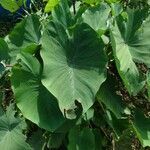Pachycaul herbs, massive, to 2.5 m, evergreen, with slightly milky latex. Stem erect to decumbent, with short stolons terminating in tubercles arising from base. Leaves several to rather many together, clustered at tips of stems of larger plants; petiole up to 1.5 m, sheath membranous; leaf blade peltate, cordate-sagittate or cordate-ovate, up to 130 × 100 cm, basal margins undulate, apex shortly acuminate; primary lateral veins 9-12 on each side, interprimary veins forming well-defined interprimary collective veins. Inflorescences 2 or 3 together among leaf bases, subtended by membranous cataphylls; peduncle stout, ca. 35 cm, exceeding cataphylls at anthesis. Spathe 13-25 cm, constricted ca. 1/6 of way from base; proximal part green, ovoid; limb cowl-like at anthesis, later reflexed, then deliquescent, greenish white, broadly oblong-lanceolate, 10-30 × 4-8 cm, membranous. Spadix shorter than spathe, shortly stipitate; female zone 1-2 × ca. 1.5 cm; pistil pale green, ca. 3 mm in diam.; stigma sessile, weakly 3-lobed, lobes blunt, pale green; sterile zone equaling male zone, ivory, very slightly narrowed corresponding to spathe constriction; synandrodes rhombic-hexagonal, ca. 2.5 mm in diam.; male zone whitish, cylindric, 3-5 × ca. 2 cm; synandria rhombic-hexagonal, convex-topped due to cap-forming synconnective, ca. 1.5 mm in diam.; appendix white, narrowly conic, 3-5.5 × 1-2 cm, equaling ca. 1/3 length of spadix, markedly thicker than male zone at base, slowly tapering toward apex. Fruiting spathe ca. 6 cm. Fruit ripening scarlet, globose, ca. 1 cm in diam.
More
A stout herb. It has spreading roots covered with long fleshy fibres. The stem is straight and thick. It has circular leaf scars along it. The leaves are arrow shaped. The base has two lobes and these are rounded. They are wavy. The leaf stalk is 60-80 cm long. It sheaths and stem at the base. The flowers are in a spadix that is a flattened cylinder shape and it has a scent.
Primary and secondary tropical rain forests, bamboo-thickets, riverbanks, swamps, also on limestone at elevations below 1,700 metres.
More
It is a tropical plant. It grows in humus rich moist soil. In Sichuan and Yunnan.


